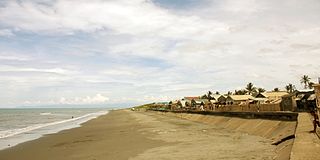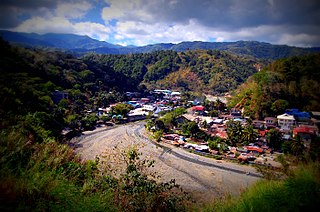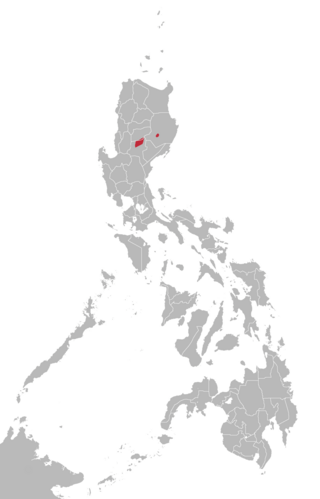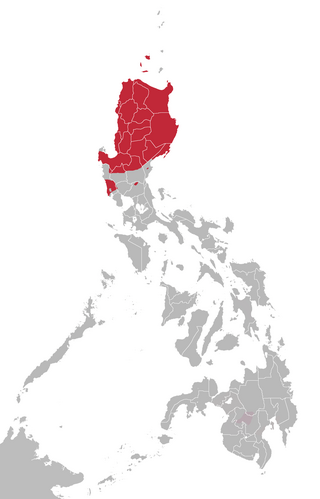Related Research Articles

Aparri, officially the Municipality of Aparri, is a 1st class municipality in the province of Cagayan, Philippines. According to the 2020 census, it has a population of 68,839 people.

Cagayan Valley, designated as Region II, is an administrative region in the Philippines. Located in the northeastern section of Luzon, it is composed of five Philippine provinces: Batanes, Cagayan, Isabela, Nueva Vizcaya, and Quirino. The region hosts four chartered cities: Cauayan, Ilagan, Santiago, and Tuguegarao.

Cagayan, officially the Province of Cagayan, is a province in the Philippines located in the Cagayan Valley region, covering the northeastern tip of Luzon. Its capital is Tuguegarao, the largest city of that province as well as the regional center of Cagayan Valley. It is about 431 kilometres (268 mi) northwest of Manila, and includes the Babuyan Islands to the north. The province borders Ilocos Norte and Apayao to the west, and Kalinga and Isabela to the south.

Isabela, officially the Province of Isabela, is the second largest province in the Philippines in land area located in the Cagayan Valley. Its capital and the largest local government unit is the city of Ilagan. It is bordered by the provinces of Cagayan to the north, Kalinga to the northwest, Mountain Province to the central-west, Ifugao and Nueva Vizcaya to the southwest, Quirino, Aurora and the independent city of Santiago to the south, and the Philippine Sea to the east.

Nueva Vizcaya, officially the Province of Nueva Vizcaya, is a landlocked province in the Philippines located in the Cagayan Valley region in Luzon. Its capital and largest town is Bayombong. It is bordered by Benguet to the west, Ifugao to the north, Isabela to the northeast, Quirino to the east, Aurora to the southeast, Nueva Ecija to the south, and Pangasinan to the southwest. Quirino province was created from Nueva Vizcaya in 1966.

The indigenous peoples of the Cordillera in northern Luzon, Philippines, often referred to by the exonym Igorot people, or more recently, as the Cordilleran peoples, are an ethnic group composed of nine main ethnolinguistic groups whose domains are in the Cordillera Mountain Range, altogether numbering about 1.8 million people in the early 21st century.

The Ibanag are an ethnolinguistic minority numbering a little more than half a million people, who inhabit the provinces of Cagayan, Isabela, and Nueva Vizcaya. They are one of the largest ethnolinguistic minorities in the Philippines.

Bagabag, officially the Municipality of Bagabag, is a 2nd class municipality in the province of Nueva Vizcaya, Philippines. According to the 2020 census, it has a population of 37,985 people.

Santiago, officially the City of Santiago, is a 1st class independent component city in the Cagayan Valley region of the Philippines. According to the 2020 census, it has a population of 148,580 people.

Angadanan, officially the Municipality of Angadanan, is a 3rd class municipality in the province of Isabela, Philippines. At the 2020 census, it had a population of 44,977.

The Gaddang language is spoken by up to 30,000 speakers in the Philippines, particularly along the Magat and upper Cagayan rivers in the Region II provinces of Nueva Vizcaya and Isabela and by overseas migrants to countries in Asia, Australia, Canada, Europe, in the Middle East, United Kingdom and the United States. Most Gaddang speakers also speak Ilocano, the lingua franca of Northern Luzon, as well as Tagalog and English. Gaddang is associated with the "Christianized Gaddang" people, and is closely related to the highland tongues of Ga'dang with 6,000 speakers, Yogad, Cagayan Agta with less than 1,000 and Atta with 2,000, and more distantly to Ibanag, Itawis, Isneg and Malaweg.

Itawis is a Northern Philippine language spoken by the Itawis people, closely related to the Gaddang speech found in Isabela and Nueva Vizcaya. It also has many similarities to the neighboring Ibanag tongue, while remaining quite different from the prevalent Ilocano spoken in the region and the Tagalog-based Filipino national language.
The Itawes, Itawis, Hitawit or Itawit (endonym) are an indigenous peoples in the Cagayan Valley of northern Luzon, Philippines. Their name is derived from the Itawes prefix i- meaning "people of" and tawid or "across the river".
Atta is an Austronesian dialect cluster spoken by the Aeta (Agta) Negritos of the northern Philippines.
Kasiguranin (Casiguranin) is a Tagalogic language that is indigenous to the Casiguran town of Aurora in the northern Philippines. It is descended from an early Tagalog dialect that had borrowed heavily from Northeastern Luzon Agta languages, and, to a lesser extent, from Ilocano, Bikol languages, Kapampangan, Gaddang, Itawis, Ibanag, and Paranan, which were spoken by settlers from other parts of the Philippines.

The Gaddang are an indigenous peoples and a linguistically identified ethnic group residing for centuries in the watershed of the Cagayan River in Northern Luzon, Philippines. Gaddang speakers were recently reported to number as many as 30,000, a number that does not include another 6,000 related Ga'dang speakers or other small linguistic-groups whose vocabularies are more than 75% identical.

The Ibanag language is an Austronesian language spoken by up to 500,000 speakers, most particularly by the Ibanag people, in the Philippines, in the northeastern provinces of Isabela and Cagayan, especially in Tuguegarao, Solana, Abulug, Camalaniugan, Lal-lo, Cabagan, Tumauini, San Pablo, Sto. Tomas, Sta. Maria, and Ilagan and other neighboring towns and villages around the Cagayan River and with overseas immigrants in countries located in the Middle East, United Kingdom, and the United States. Most of the speakers can also speak Ilocano, the lingua franca of northern Luzon island. The name Ibanag comes from the prefix I which means 'people of', and bannag, meaning 'river'. It is closely related to Gaddang, Itawis, Agta, Atta, Yogad, Isneg, and Malaweg.

The Northern Luzon languages are one of the few established large groups within Philippine languages. These are mostly located in and around the Cordillera Central of northern Luzon in the Philippines. Among its major languages are Ilocano, Pangasinan and Ibanag.
Gaddang or Ga'dang may be,
The Cagayan Heritage Conservation Society is a nonprofit organization aimed at spreading awareness about Cagayan's history and culture through education & research, training, and policy reform. It was founded in 2018.
References
- Robinson, Laura C. and Jason William Lobel (2013). "The Northeastern Luzon Subgroup of Philippine Languages." Oceanic Linguistics 52.1 (2013): 125–168.